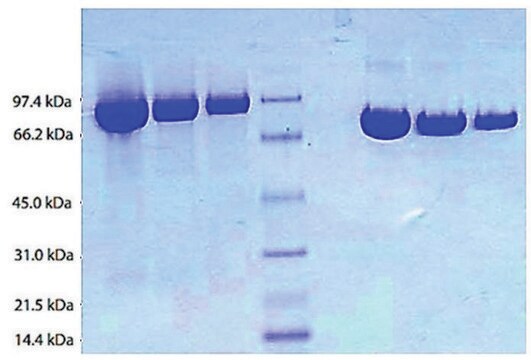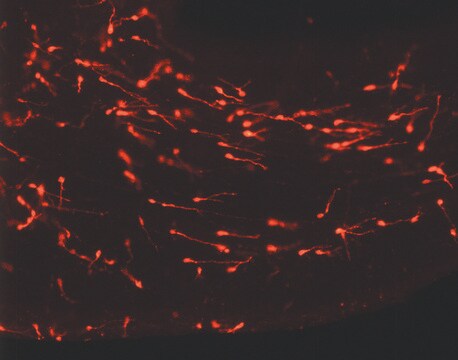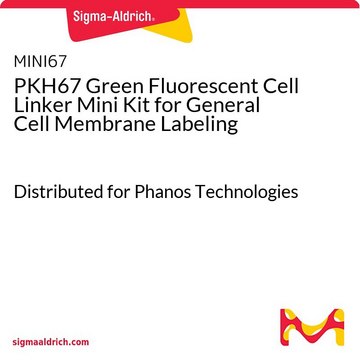T2943
Tissue plasminogen activator chromogenic substrate
≥95% (HPLC), solid
Synonym(s):
TPA Activity Assay
Sign Into View Organizational & Contract Pricing
All Photos(1)
About This Item
Recommended Products
Quality Level
Assay
≥95% (HPLC)
form
solid
mol wt
apparent mol wt 658.9
solubility
methanol: water (1:9): 25 mg/mL
storage temp.
2-8°C
General description
Tissue plasminogen activator chromogenic substrate is a highly sensitive chromogenic peptide substrate for tissue plasminogen activator (tPA). It shows different sensitivity to native single-chain tPA (sc-tPA) and its fully active two-chain form (tc-tPA).
Application
Tissue plasminogen activator chromogenic substrate has been used:
- in tissue plasminogen activator inhibition assay
- to determine the plasminogen activator (PA) activity by studying the glycosylation properties of tissue plasminogen activator (tPA) activities in effusions using concanavalin A-Sepharose (conA-S) chromatography
- in inhibition assays and complex formation analyses of wild type (WT) neuroserpin (NS) and its variants
Storage Class Code
11 - Combustible Solids
WGK
WGK 3
Flash Point(F)
Not applicable
Flash Point(C)
Not applicable
Personal Protective Equipment
dust mask type N95 (US), Eyeshields, Gloves
Certificates of Analysis (COA)
Search for Certificates of Analysis (COA) by entering the products Lot/Batch Number. Lot and Batch Numbers can be found on a product’s label following the words ‘Lot’ or ‘Batch’.
Already Own This Product?
Find documentation for the products that you have recently purchased in the Document Library.
Mahdieh Bayat et al.
Journal of biotechnology, 280, 1-10 (2018-05-29)
The aim of the present study was to investigate the effect of three routine drug excipients, as osmolytes, in three different concentrations, on structure, thermal stability and the activity of single-chain (sc-) tenecteplase. To see the influence of trehalose, mannitol
Mohammad Farhan Ali et al.
Scientific reports, 7, 42987-42987 (2017-02-24)
Neuroserpin (NS) mediated inhibition of tissue-type plasminogen activator (tPA) is important for brain development, synapse formation and memory. Aberrations in helix F and β-sheet A movement during inhibition can directly lead to epilepsy or dementia. Conserved W154 residue in a
Jesse Cahill et al.
Frontiers in molecular biosciences, 7, 574477-574477 (2020-10-08)
Although chemically inert, Xe and other noble gases have been shown to have functional effects on biological systems. For example, Xe is a powerful anesthetic with neuroprotective properties. Recent reports have claimed that Xe inhibits the activity of tissue plasminogen
Mahdieh Bayat et al.
International journal of biological macromolecules, 130, 863-877 (2019-03-09)
Organic osmolytes, as major cellular compounds, cause protein stabilization in the native form. In the present study, the possible chaperone effects of the three naturally occurring osmolytes on the two-chain form of tenecteplase (tc-TNK), a recombinant, genetically engineered mutant tissue
Deepa Gautam et al.
Frontiers in cell and developmental biology, 10, 834016-834016 (2022-04-08)
Prion peptide (PrP) misfolds to infectious scrapie isoform, the β pleat-rich insoluble fibrils responsible for neurodegeneration and fatal conformational diseases in humans. The amino acid sequence 106-126 from prion proteins, PrP(106-126), is highly amyloidogenic and implicated in prion-induced pathologies. Here
Our team of scientists has experience in all areas of research including Life Science, Material Science, Chemical Synthesis, Chromatography, Analytical and many others.
Contact Technical Service







